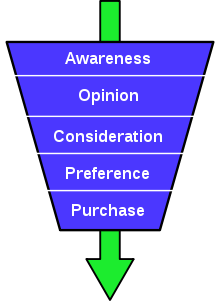Purchase funnel

The purchase funnel, or purchasing funnel, is a consumer focused marketing model which illustrates the theoretical customer journey towards the purchase of a product or service.
In 1898, E. St. Elmo Lewis developed a model which mapped a theoretical customer journey from the moment a brand or product attracted consumer attention to the point of action or purchase.[1] St. Elmo Lewis’ idea is often referred to as the AIDA-model, an acronym which stands for Awareness, Interest, Desire, and Action. This staged process is summarized below:
- Awareness – the customer is aware of the existence of a product or service
- Interest – actively expressing an interest in a product group
- Desire – aspiring to a particular brand or product
- Action – taking the next step towards purchasing the chosen product
The Purchase Funnel is also often referred to as the “customer funnel,” “marketing funnel,” or “sales funnel” or "conversion funnel." The association of the funnel model with the AIDA concept was first proposed in Bond Salesmanship by William W. Townsend in 1924.[2]
This early model has been modified by marketing consultants and academics to cater to the modern customer and is now referred to in marketing as the purchase funnel or buying funnel. Many different business-to-consumer purchase models exist in marketing today, but it is generally accepted that the modern business-to-business purchase funnel has more stages,[3] considers repurchase intent and takes into account new technologies and changes in consumer purchase behavior.[4][5] As a model, the buying funnel has been validated in a variety of domains, including searching,[6] keyword advertising,[7] and lead generation[8] but also modified to include previously unconsidered steps and metrics such as outbound sales and internet impressions.[9]
The purchase funnel concept is used in marketing to guide promotional campaigns targeting different stages of the customer journey, and also as a basis for customer relationship management (CRM) programmes and lead management campaigns.
Conversion Funnel
Similar to a purchase funnel, 'conversion funnel' is a technical term used in e-commerce operations to describe the track a consumer takes through an Internet advertising or search system, navigating an e-commerce website and finally converting to a sale.
See also
- DAGMAR marketing
- Sales process
- Customer relationship management
- Customer lifecycle management
- Lead generation
References
- ↑ E. K. Strong, Jr. The Psychology of Selling and Advertising. New York 1925, p. 349 and p. 9.
- ↑ "The salesman should visualize his whole problem of developing the sales steps as the forcing by compression of a broad and general concept of facts through a funnel which produces the specific and favorable consideration of one fact. The process is continually from the general to the specific, and the visualizing of the funnel has helped many salesmen to lead a costumer from Attention to Interest, and beyond" (p. 109).
- ↑ A modern purchase funnel concept - Marketing-made-simple.com (2009)
- ↑ The customer decision journey - McKinsey Quarterly(2009)
- ↑ Branding In The Digital Age - You're Spending Your Money in All the Wrong Places
- ↑ Kules, Bill. "Speaking the same language about exploratory information seeking." Information Seeking Support Systems 13.5 (2008): 17.
- ↑ Jansen, B. J. and Schuster, S. (2011) Bidding on the Buying Funnel for Sponsored Search Campaigns. Journal of Electronic Commerce Research. 12(1), 1-18.
- ↑ Wilcox, G., & Sussman, K. (2014). Lead-generating social media strategies using the social media performance model: The B2B connection. Journal of Digital & Social Media Marketing, 2(1), 70-78.
- ↑ "How The B2B Marketing Funnel Works". www.bizible.com. Retrieved 2016-01-06.